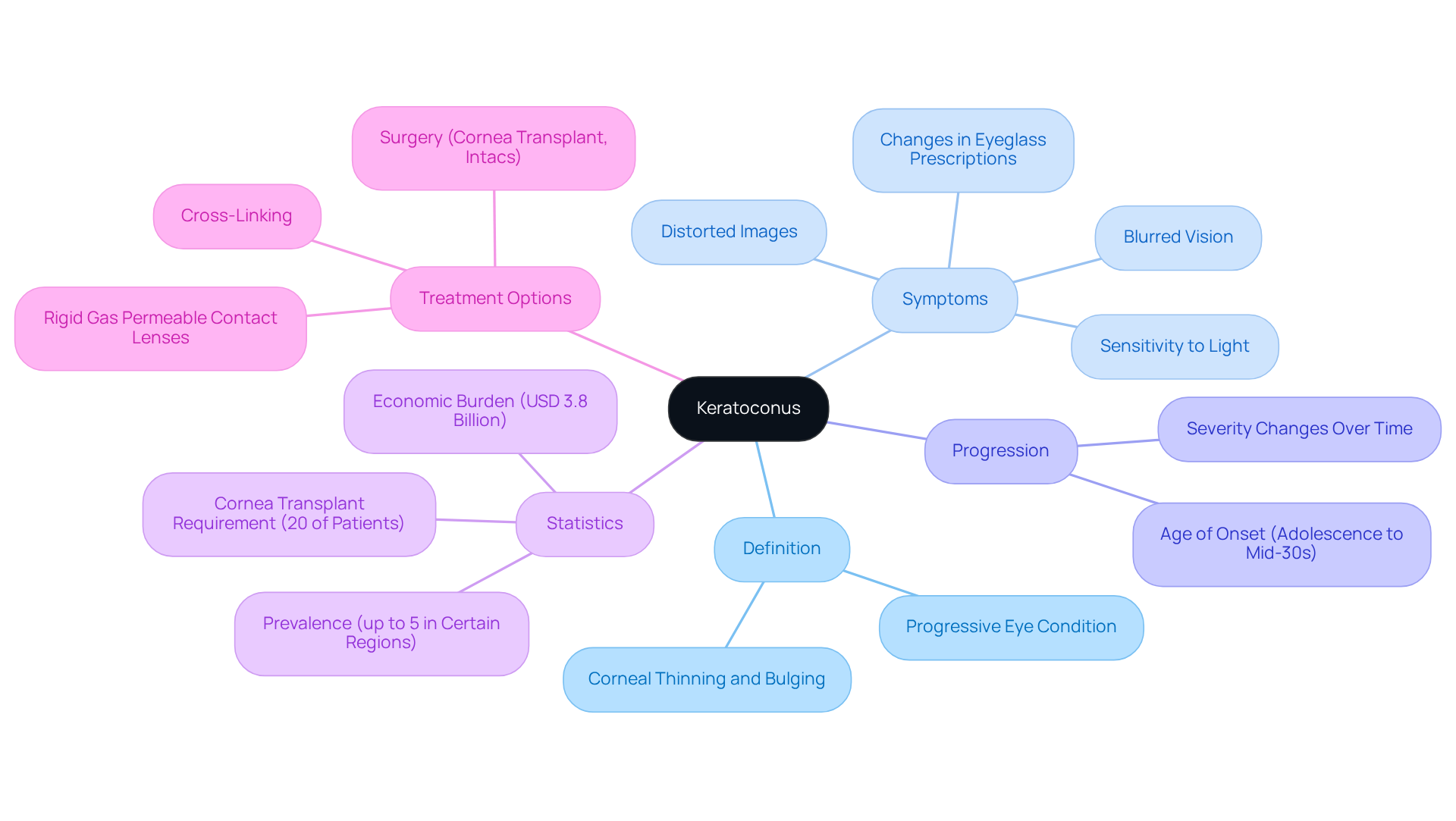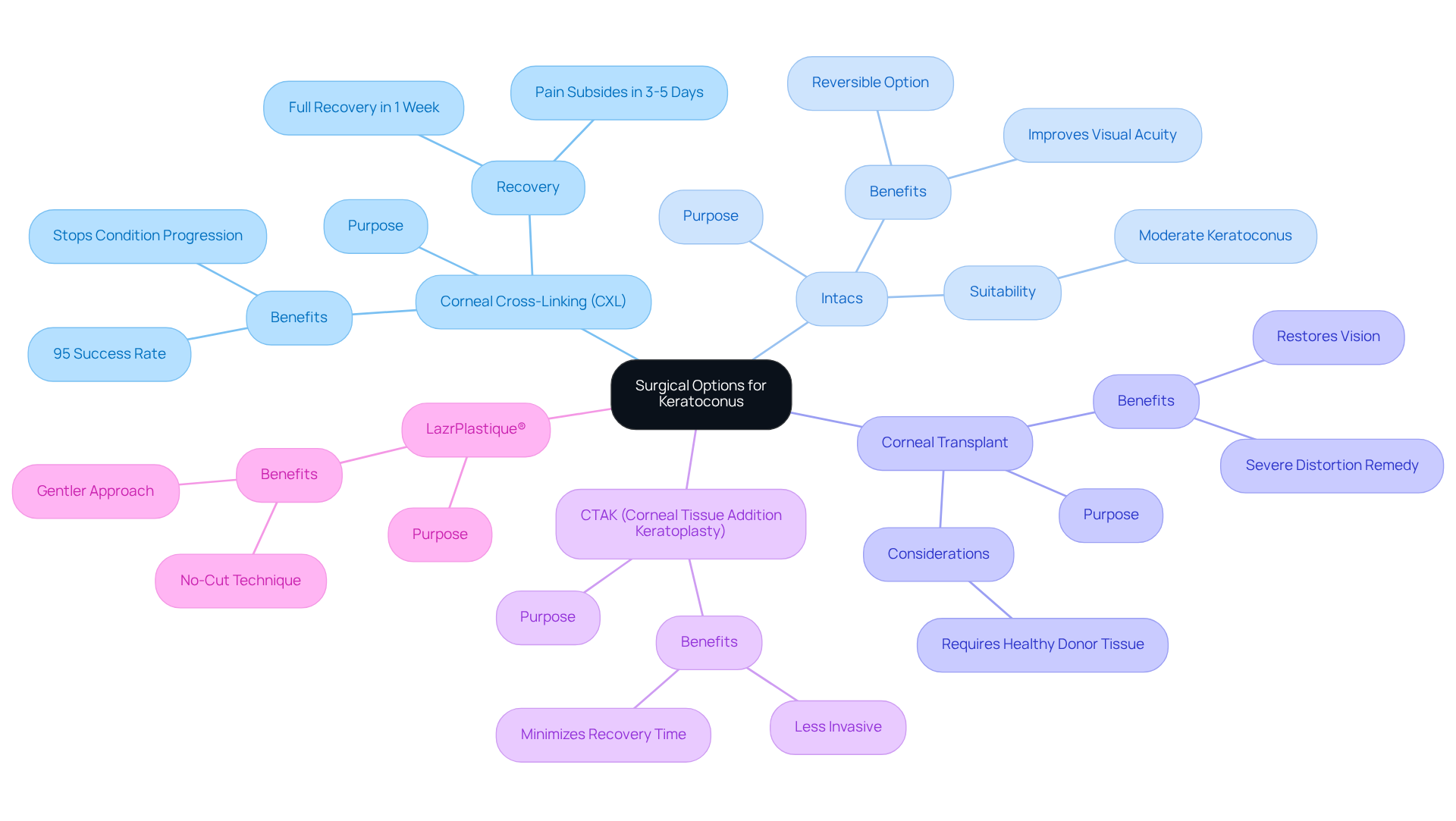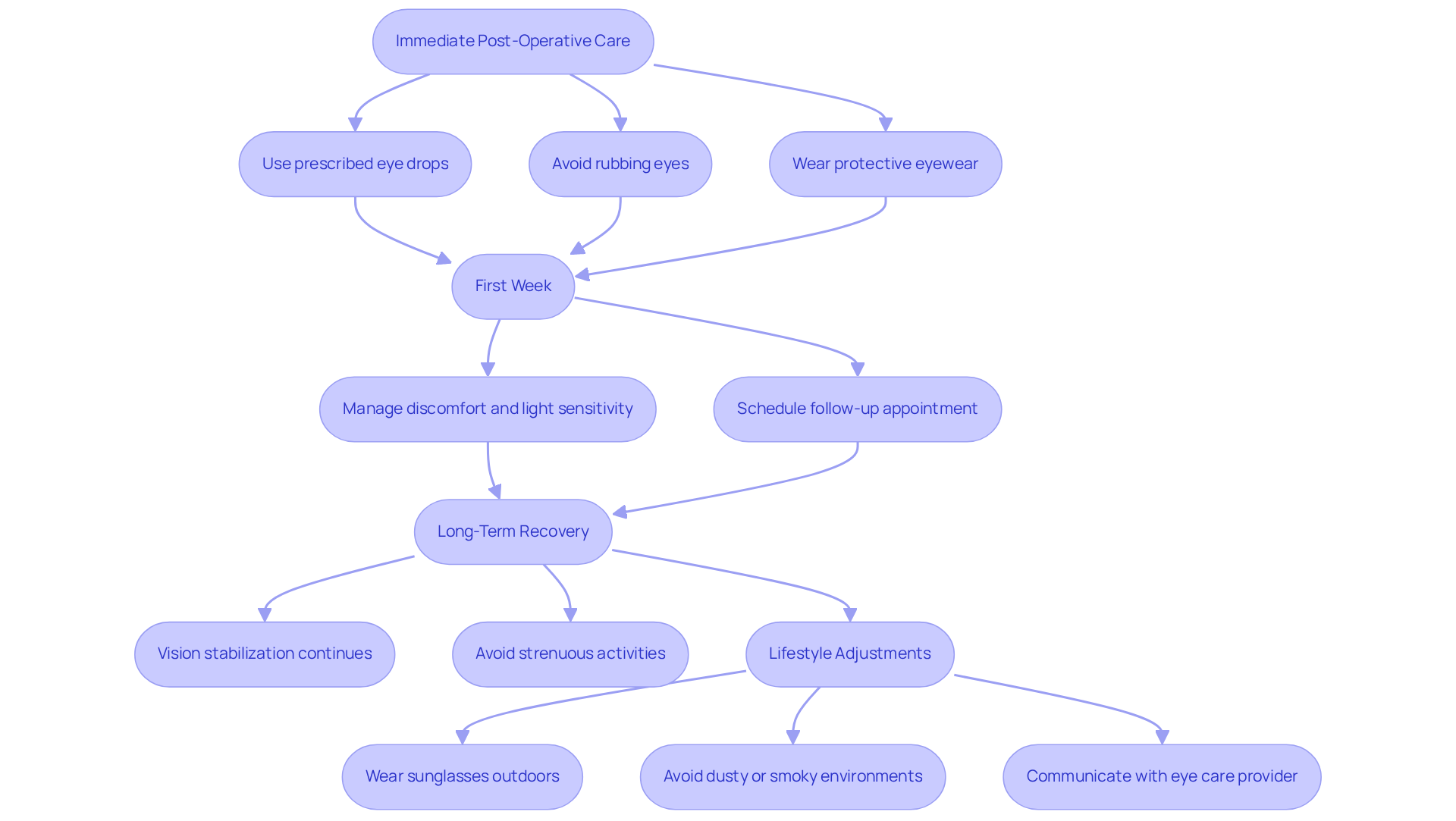Posted by: Northwest Eye in General on August 25, 2025
Overview
Keratoconus surgery provides a range of treatment options designed with your needs in mind. These include:
- Corneal cross-linking
- Intacs
- Corneal transplants
- CTAK
- LazrPlastique®
Each option is tailored to address the severity of your condition and enhance your visual acuity.
We understand that considering surgery can be overwhelming. This article outlines these surgical techniques in detail, helping you to feel informed and empowered about your choices. It’s also important to recognize the role of post-operative care and recovery expectations. We want to ensure that you are aware of the necessary steps for optimal healing.
Remember, you are not alone on this journey. Many patients have successfully navigated these options and have found reassurance in understanding what to expect. We are here to help you through this process, supporting you every step of the way.
Introduction
Keratoconus is a progressive eye disorder that can significantly affect your vision, often leading to feelings of anxiety and uncertainty. We understand that this can be a challenging experience. Thankfully, with advancements in surgical techniques, there are now multiple options available to help restore your sight and improve your quality of life.
However, we recognize that navigating these choices and understanding the recovery process can feel daunting. What are the most effective surgical interventions for keratoconus, and how can you ensure a smooth recovery journey? We are here to help you through this process.
Understand Keratoconus: Definition, Symptoms, and Progression
Keratoconus is a progressive eye condition that can be concerning for many. It is characterized by the thinning and bulging of the cornea into a cone shape, which distorts light entering the eye and leads to blurred and distorted sight. We understand that experiencing distorted vision can be unsettling, as it may arise from various irregularities, including corneal deformity, and can indicate the existence of other eye conditions. Common symptoms include:
- Blurred vision that worsens over time
- Increased sensitivity to light and glare
- Frequent changes in eyeglass prescriptions
- Distorted images, where straight lines appear wavy
The progression of keratoconus typically begins in adolescence and can continue into the mid-30s. In its early stages, symptoms may be mild, but as the condition advances, vision deterioration can become significant. It’s common to feel anxious about these changes, and often, keratoconus surgery may be necessary to restore visual acuity and corneal integrity.
Statistics show that this eye condition impacts up to 5% of the population in specific areas, especially in the Middle East, with the highest occurrence noted in individuals aged 18 to 39 years. Approximately 20% of patients may progress to a stage requiring a cornea transplant. Understanding these aspects is crucial for you to seek as the condition evolves. Recent advancements in imaging technologies and therapies have improved early diagnosis and management, enhancing the quality of life for those affected.
At Northwest Eye, we are here to help you through this process. This corneal condition is addressed within the broader context of our comprehensive eye condition library, ensuring that you receive the education and support you need.

Explore Surgical Options for Keratoconus: Techniques and Procedures
A variety of surgical options are available for treating keratoconus, each designed to effectively address the severity of the condition. We understand that keratoconus can bring about symptoms such as blurry or double vision, difficulty with distance vision, and light sensitivity, which can significantly impact daily life. Initial treatment options may include specially fitted contact lenses to correct eye distortion.
- Corneal Cross-Linking (CXL): This minimally invasive procedure utilizes riboflavin (vitamin B2) and ultraviolet light to enhance the eye’s surface by forming new bonds in the tissue. With an impressive , CXL effectively stops the advancement of the condition and stabilizes sight. Patients typically experience minimal complications, and recovery timelines vary based on the method used.
- Intacs: These small, crescent-shaped inserts are placed within the eye’s surface to flatten its shape and enhance vision. Intacs are particularly suitable for patients with moderate keratoconus, offering a reversible option that can improve visual acuity.
- Corneal Transplant: In advanced cases where the transparent front part of the eye is severely distorted, a corneal transplant may be necessary. This procedure involves substituting the damaged eye tissue with healthy donor tissue, providing a remedy for significant vision impairment.
- CTAK (Corneal Tissue Addition Keratoplasty): This innovative technique employs tissue grafts to reshape the eye’s surface, presenting a less invasive alternative to traditional transplants. It aims to restore eye integrity while minimizing recovery time.
- LazrPlastique®: A no-cut laser technique that reshapes the cornea without incisions, LazrPlastique® offers a gentler approach to correcting corneal irregularities, making it an appealing option for patients seeking non-invasive solutions.
Each of these procedures comes with specific indications, benefits, and recovery protocols. Therefore, it is crucial for patients to engage in thorough discussions with their ophthalmic surgeon to determine the most appropriate course of action tailored to their individual needs. Remember, we are here to help you through this process.

Navigate Post-Surgery Recovery: Care and Expectations
Recovery after keratoconus surgery can vary depending on the specific procedure performed, and we recognize that this can be a time of uncertainty. Here are some essential guidelines and what you can expect:
Immediate Post-Operative Care:
- We encourage you to utilize the prescribed antibiotic and anti-inflammatory eye drops to help prevent infection and minimize inflammation.
- It’s common to feel the urge to rub or touch your eyes, but please refrain from doing so to avoid complications.
- Wearing protective eyewear as advised by your surgeon is crucial for your safety.
First Week:
- You may anticipate some . These symptoms are typical and should gradually improve over time.
- We recommend scheduling a follow-up appointment with your surgeon to monitor your healing and address any concerns you may have.
Long-Term Recovery:
- Vision stabilization may continue over several weeks, and regular follow-up appointments are essential to evaluate your progress and modify corrective measures as needed.
- During the initial recovery phase, it’s important to avoid strenuous activities and bright light exposure to support your healing process.
Lifestyle Adjustments:
- Implementing protective measures, such as wearing sunglasses outdoors and steering clear of dusty or smoky environments, can significantly aid your recovery.
- Please maintain open communication with your eye care provider regarding any unusual symptoms or concerns during your recovery journey.
By following these guidelines, you can optimize your outcomes from keratoconus surgery and facilitate a smoother recovery process. Research shows that most patients observe considerable enhancements in their vision within the first week following procedures such as cross-linking of the cornea, with complete effects possibly requiring several months to fully appear. Regular eye exams are recommended to monitor your corneal health and ensure long-term success. Remember, we are here to help you through this process.

Conclusion
Keratoconus surgery offers a range of options tailored to the severity of the condition, providing hope for those affected by this progressive eye disorder. We understand that navigating this journey can be challenging, and it’s essential to grasp the intricacies of keratoconus, including its symptoms and the significance of timely intervention, to manage vision deterioration effectively. With advancements in surgical techniques such as Corneal Cross-Linking, Intacs, and innovative methods like LazrPlastique®, patients can explore effective solutions to restore their visual acuity and improve their quality of life.
The importance of comprehensive care before, during, and after surgery cannot be overstated. From the initial recognition of symptoms to the various surgical options available and the necessary post-operative recovery steps, each phase plays a critical role in achieving optimal outcomes. It’s common to feel overwhelmed, but emphasizing the need for ongoing communication with eye care providers and adherence to recovery protocols is vital for ensuring long-term success and stability in vision.
Ultimately, awareness and education about keratoconus and its treatment options empower individuals to take proactive steps toward better eye health. By seeking appropriate care and staying informed about the latest advancements in keratoconus surgery, patients can navigate their journey with confidence. Remember, we are here to help you through this process, ensuring you receive the support and resources needed for a successful recovery and improved quality of life.
Frequently Asked Questions
What is keratoconus?
Keratoconus is a progressive eye condition characterized by the thinning and bulging of the cornea into a cone shape, which distorts light entering the eye and leads to blurred and distorted vision.
What are the common symptoms of keratoconus?
Common symptoms include blurred vision that worsens over time, increased sensitivity to light and glare, frequent changes in eyeglass prescriptions, and distorted images where straight lines appear wavy.
When does keratoconus typically begin and how does it progress?
Keratoconus typically begins in adolescence and can continue into the mid-30s. In its early stages, symptoms may be mild, but as the condition advances, vision deterioration can become significant.
What percentage of the population is affected by keratoconus?
Statistics show that keratoconus impacts up to 5% of the population in specific areas, especially in the Middle East, with the highest occurrence noted in individuals aged 18 to 39 years.
How many patients with keratoconus may require a cornea transplant?
Approximately 20% of patients with keratoconus may progress to a stage that requires a cornea transplant.
What advancements have been made in the management of keratoconus?
Recent advancements in imaging technologies and therapies have improved early diagnosis and management of keratoconus, enhancing the quality of life for those affected.
How can individuals seek support for keratoconus?
Individuals can seek support and education about keratoconus through resources like Northwest Eye, which provides information and assistance related to this corneal condition.






